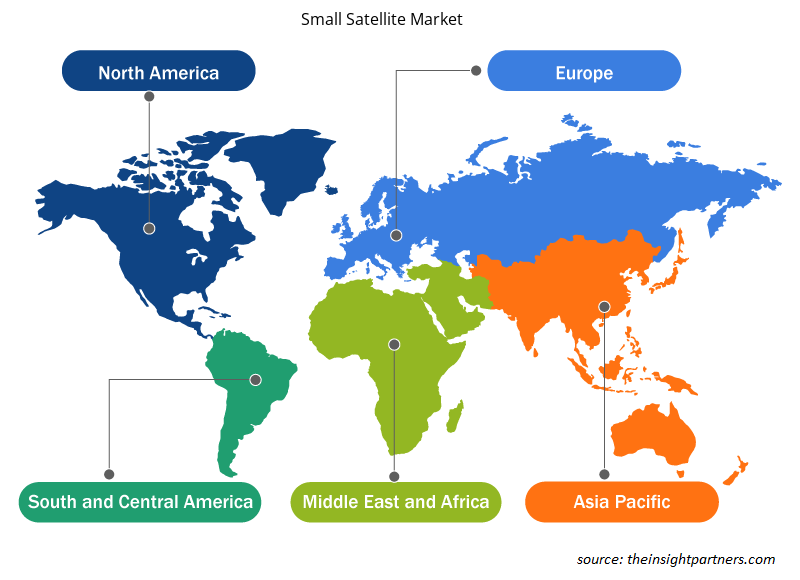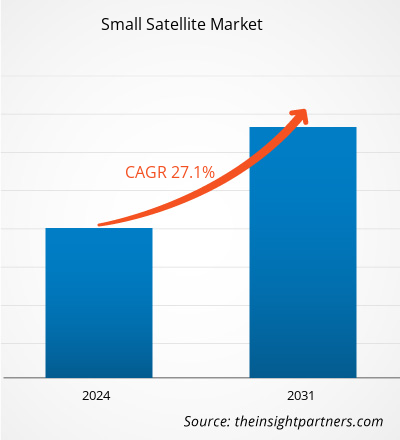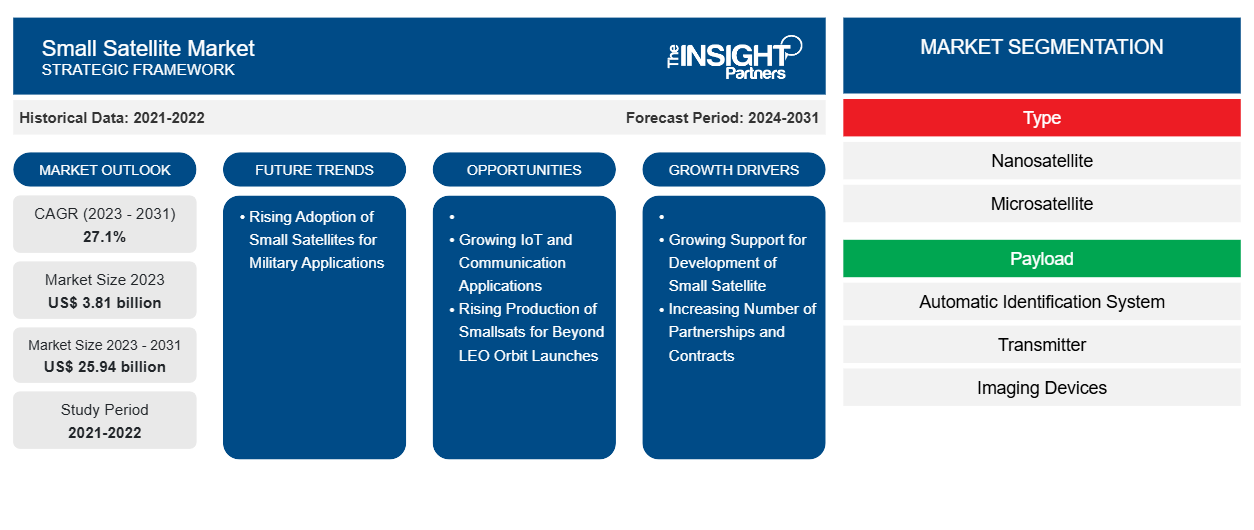Se prevé que el tamaño del mercado de satélites pequeños alcance los 25.940 millones de dólares en 2031, frente a los 3.810 millones de dólares en 2023. Se espera que el mercado registre una CAGR del 27,1 % entre 2023 y 2031. Es probable que la creciente adopción de satélites pequeños para aplicaciones militares siga siendo una tendencia clave en el mercado de satélites pequeños.
Análisis del mercado de satélites pequeños
Muchas empresas emergentes en el mercado de satélites pequeños han experimentado una disminución en el crecimiento de sus negocios y operaciones debido a varios desafíos debido al inicio de la pandemia, incluidos retrasos en los proyectos de lanzamiento de satélites y entregas de productos debido a los desafíos de la cadena de suministro y las inversiones mínimas en el sector de los satélites pequeños. Además, el crecimiento en el desarrollo de nanosatélites con la ayuda de inversiones en toda la industria de satélites pequeños para futuros proyectos de lanzamiento de constelaciones también está impulsando el crecimiento comercial de los proveedores del ecosistema de satélites pequeños . Este crecimiento se debe principalmente al aumento de la demanda de componentes de satélites pequeños, como sensores, transmisores, dispositivos de imágenes, transpondedores, antenas, sistemas de identificación automática, etc., para la producción de satélites pequeños.
Panorama del mercado de satélites pequeños
Los fabricantes de satélites pequeños ofrecen una amplia gama de satélites, como picosatélites, nanosatélites y microsatélites. Estos satélites se utilizan para diversas aplicaciones, entre ellas la observación de la Tierra, la comunicación y la navegación y la investigación científica. Además, la creciente demanda de servicios basados en satélites por parte de los sectores comercial y militar está influyendo aún más en la demanda de satélites pequeños. Algunos de los principales actores que operan en el mercado global de satélites pequeños son Northrop Grumman Corporation, L3Harris Technologies Inc., Thales Group, Millennium Space Systems Inc. (una empresa de Boeing), Space Exploration Technologies Corp. (SpaceX) y Surrey Satellite Technology Ltd.
Personalice este informe según sus necesidades
Obtendrá personalización en cualquier informe, sin cargo, incluidas partes de este informe o análisis a nivel de país, paquete de datos de Excel, así como también grandes ofertas y descuentos para empresas emergentes y universidades.
-
Obtenga las principales tendencias clave del mercado de este informe.Esta muestra GRATUITA incluirá análisis de datos, desde tendencias del mercado hasta estimaciones y pronósticos.
Factores impulsores y oportunidades del mercado de satélites pequeños
Aumento del número de asociaciones y contratos
La creciente necesidad de satélites pequeños alienta a los actores del mercado a establecer alianzas, colaboraciones y contratos estratégicos. A continuación se mencionan algunas estrategias de los actores:
- En abril de 2022, la NASA adjudicó un contrato de 280 millones de dólares a empresas de SATCOM para desarrollar servicios de comunicación espacial cercana a la Tierra. En virtud de este contrato, Space Exploration Technologies de Elon Musk se adjudica la mayor cantidad, 69,95 millones de dólares, seguida de Kuiper Government Solutions (67 millones de dólares), Viasat Incorporated (53,3 millones de dólares), Inmarsat Government (28,6 millones de dólares), SES Government Solutions (28,96 millones de dólares) y Telesat US Services (30,65 millones de dólares).SATCOM companies to develop near-Earth space communication services. Under this contract, Elon Musk's Space Exploration Technologies is awarded the largest amount of US$ 69.95 million, followed by Kuiper Government Solutions (US$ 67 million), Viasat Incorporated (US$ 53.3 million), Inmarsat Government (US$ 28.6 million), SES Government Solutions (US$ 28.96 million), and Telesat U.S. Services (US$ 30.65 million).
- En julio de 2022, Vaya Space, Inc. anunció la firma de un acuerdo con All2Space para lanzar su constelación de satélites. All2Space es un desarrollador de CubeSat y también es un agregador de lanzamiento de la Agencia Espacial Brasileña.Vaya Space, Inc. announced the signing of an agreement with All2Space to launch its satellite constellation. All2Space is a developer of CubeSat and is also a launch aggregator with Brazilian Space Agency.
- En septiembre de 2021, la Organización de Investigación Espacial de la India (ISRO) anunció la firma de un contrato con el departamento de telecomunicaciones de Bután para desarrollar un pequeño satélite.
Varias empresas están firmando contratos y colaborando para proporcionar satélites pequeños para diversas aplicaciones, como comunicaciones, navegación y observación de la Tierra. Por lo tanto, el creciente número de iniciativas de este tipo impulsa el crecimiento del mercado de satélites pequeños.
Crecientes aplicaciones de IoT y comunicación: una oportunidad en el mercado de satélites pequeños
El acceso a Internet, la comunicación máquina a máquina (M2M) y el Internet de las cosas (IoT) se encuentran entre las aplicaciones más importantes de un pequeño satélite . El espacio se ha convertido en una solución ideal para mejorar la eficiencia de las redes de comunicación terrestres actuales. Según Alén Space, para 2025, se prevé que existan más de 25.200 millones de conexiones IoT en todo el mundo, y el mercado de IoT alcanzará los 1.072,08 billones de dólares (950.000 millones de euros). Además, las constelaciones de pequeños satélites pueden desempeñar un papel importante en diversas condiciones ambientales, especialmente en lugares remotos o de difícil acceso, donde se reciben datos en tiempo real de todo tipo de sensores y dispositivos vinculados para modelos de negocio basados en IoT. Así, un pequeño satélite ayuda a recibir, almacenar y transmitir información en tiempo real a cualquier punto.
Análisis de segmentación del informe del mercado de satélites pequeños
Los segmentos clave que contribuyeron a la derivación del análisis del mercado de satélites pequeños son el tipo, la carga útil, la aplicación y la vertical.
- Según el tipo, el mercado de satélites pequeños se divide en nanosatélites (de 1 a 10 kg) y microsatélites (de 10 a 150 kg). El segmento de microsatélites tuvo una mayor participación de mercado en 2023.
- Según la aplicación, el mercado de satélites pequeños se segmenta en observación de la Tierra, comunicaciones y navegación e investigación científica. El segmento de observación de la Tierra tuvo una mayor participación de mercado en 2023.
- Según la aplicación, el mercado de satélites pequeños se segmenta en sistemas de identificación automática (AIS), transmisores, dispositivos de imágenes y otros. El segmento de sistemas de identificación automática (AIS) tuvo una mayor participación de mercado en 2023.
- Según el usuario final, el mercado de satélites pequeños se divide en gubernamental, militar y comercial. El segmento comercial tuvo una mayor participación de mercado en 2023.
Análisis de la cuota de mercado de los satélites pequeños por geografía
El alcance geográfico del informe del mercado de satélites pequeños se divide principalmente en cinco regiones: América del Norte, Asia Pacífico, Europa, Medio Oriente y África, y América del Sur.
En 2023, América del Norte representó una parte importante del mercado mundial de satélites pequeños, seguida de Asia Pacífico y Europa. Además, es probable que Asia Pacífico registre la CAGR más alta durante el período 2023-2031. Se espera que el enfoque de la industria espacial en países como China, India, Japón, Corea del Sur, Tailandia, Vietnam y Taiwán influya en el crecimiento del mercado de satélites pequeños durante el período de pronóstico. Se espera que el rápido desarrollo económico, la adopción de tecnologías avanzadas en la industria espacial y la creciente adopción de servicios espaciales en el sector comercial impulsen el crecimiento del mercado en la región en los próximos años.
Perspectivas regionales del mercado de satélites pequeños
Los analistas de Insight Partners explicaron en detalle las tendencias y los factores regionales que influyen en el mercado de satélites pequeños durante el período de pronóstico. Esta sección también analiza los segmentos y la geografía del mercado de satélites pequeños en América del Norte, Europa, Asia Pacífico, Oriente Medio y África, y América del Sur y Central.

- Obtenga los datos regionales específicos para el mercado de satélites pequeños
Alcance del informe sobre el mercado de satélites pequeños
| Atributo del informe | Detalles |
|---|---|
| Tamaño del mercado en 2023 | 3.810 millones de dólares estadounidenses |
| Tamaño del mercado en 2031 | US$ 25.94 mil millones |
| CAGR global (2023 - 2031) | 27,1% |
| Datos históricos | 2021-2022 |
| Período de pronóstico | 2024-2031 |
| Segmentos cubiertos |
Por tipo
|
| Regiones y países cubiertos |
América del norte
|
| Líderes del mercado y perfiles de empresas clave |
|
Densidad de actores del mercado: comprensión de su impacto en la dinámica empresarial
El mercado de satélites pequeños está creciendo rápidamente, impulsado por la creciente demanda de los usuarios finales debido a factores como la evolución de las preferencias de los consumidores, los avances tecnológicos y una mayor conciencia de los beneficios del producto. A medida que aumenta la demanda, las empresas amplían sus ofertas, innovan para satisfacer las necesidades de los consumidores y aprovechan las tendencias emergentes, lo que impulsa aún más el crecimiento del mercado.
La densidad de actores del mercado se refiere a la distribución de las empresas o firmas que operan dentro de un mercado o industria en particular. Indica cuántos competidores (actores del mercado) están presentes en un espacio de mercado determinado en relación con su tamaño o valor total de mercado.
Las principales empresas que operan en el mercado de satélites pequeños son:
- Dauria Aeroespacial
- Grupo GomSpace AB
- Corporación Lockheed Martin
- Corporación Northrop Grumman
- Corporación Raytheon Technologies
- Corporación Sierra Nevada
Descargo de responsabilidad : Las empresas enumeradas anteriormente no están clasificadas en ningún orden particular.

- Obtenga una descripción general de los principales actores clave del mercado de satélites pequeños
Noticias y desarrollos recientes del mercado de satélites pequeños
El mercado de satélites pequeños se evalúa mediante la recopilación de datos cualitativos y cuantitativos a partir de investigaciones primarias y secundarias, que incluyen publicaciones corporativas importantes, datos de asociaciones y bases de datos. A continuación, se incluye una lista de los avances en el mercado en materia de innovaciones, expansión comercial y estrategias:
- En 2022, la Agencia de Desarrollo Espacial (SDA, por sus siglas en inglés) le ha otorgado a Lockheed Martin un contrato de prototipo para el desarrollo y la producción de 42 satélites pequeños, con un valor potencial de casi 700 millones de dólares. Estos satélites son parte del Tranche 1, las capacidades de combate iniciales de la capa de transporte de la agencia, que vincularán los demás dominios de la Tierra con el espacio en un entorno en red de alta capacidad conocido como Operaciones Conjuntas de Todos los Dominios. (Fuente: SDA, Nota de Prensa)
- En 2022, Terran Orbital aprovecha el auge del mercado de los satélites pequeños. La empresa amplió su negocio de satélites y anunció planes para construir una nueva planta de fabricación en Florida. (Fuente: Terran Orbital, boletín informativo)
Informe sobre el mercado de satélites pequeños: cobertura y resultados
El informe “Tamaño y pronóstico del mercado de satélites pequeños (2021-2031)” proporciona un análisis detallado del mercado que cubre las siguientes áreas:
- Tamaño del mercado de satélites pequeños y pronóstico a nivel mundial, regional y nacional para todos los segmentos clave del mercado cubiertos bajo el alcance
- Dinámica del mercado, como impulsores, restricciones y oportunidades clave
- Tendencias del mercado de satélites pequeños
- Las cinco fuerzas de Porter detalladas
- Análisis del mercado de satélites pequeños que abarca las tendencias clave del mercado, el marco global y regional, los principales actores, las regulaciones y los desarrollos recientes del mercado
- Panorama de la industria de satélites pequeños y análisis de la competencia que abarca la concentración del mercado, análisis de mapas de calor, actores destacados y desarrollos recientes
- Perfiles detallados de empresas
- Análisis histórico (2 años), año base, pronóstico (7 años) con CAGR
- Análisis PEST y FODA
- Tamaño del mercado, valor/volumen: global, regional y nacional
- Industria y panorama competitivo
- Conjunto de datos de Excel
Informes recientes
Testimonios
Razón para comprar
- Toma de decisiones informada
- Comprensión de la dinámica del mercado
- Análisis competitivo
- Información sobre clientes
- Pronósticos del mercado
- Mitigación de riesgos
- Planificación estratégica
- Justificación de la inversión
- Identificación de mercados emergentes
- Mejora de las estrategias de marketing
- Impulso de la eficiencia operativa
- Alineación con las tendencias regulatorias























 Obtenga una muestra gratuita para - Mercado de satélites pequeños
Obtenga una muestra gratuita para - Mercado de satélites pequeños